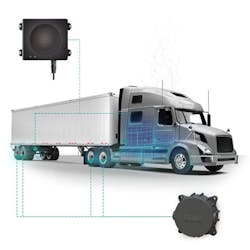Smarter Tire Tactics: Predictive Monitoring Plus Automatic Inflation
What you'll learn:
- The importance of mandatory TPMS/ATIS for all new vehicles.
- How does Aperia's Halo Connect i3 automatic inflation system work?
- Benefits of the Halo Connect i3 platform.
Since 2007, every new vehicle manufactured in the U.S. has been required to include a tire pressure monitoring system (TPMS). The purpose of the TPMS is to warn that at least one or more tires are significantly underinflated. Underinflation often leads to increased and uneven wear, which can drive up the frequency of tire replacement.
An indirect TPMS relies on wheel speed sensors used by the anti-lock brake system. These sensors, which measure the rate of revolution each wheel is making, can be used to compare with each other and to other vehicle operation data such as speed.
When a wheel starts spinning faster than expected, the onboard computer can calculate that the tire is underinflated. Direct TPMS uses pressure-monitoring sensors within each tire that monitor specific pressure levels, not just wheel revolution data.
Similarly, an automatic tire inflation system (ATIS) uses compressed air from the trailer air brake system to inflate any tire when its pressure decreases below the system air pressure setting. Check valves in the tire hoses or hub caps isolate each tire so that loss of air in a single tire will not affect the pressure in the other tires.
The ATIS indicator light will illuminate when the system is active. An ATIS system that can work with both its tire-pressure monitors and telematics systems (Bluetooth, RF, CAN, GPS, and LTE connectivity) creates a complete system.
The latest TPMS and ATIS systems are designed to keep drivers up-to-date on their tires to get the most optimal tread wear possible. European legislation will require all trailers manufactured after July 2024 to have ATIS or TPMS.
Halo Connect: Predictive Monitoring and Automatic Inflation
Aperia Technologies is the manufacturer of the Halo Connect system for tractors and trailers. The self-powered technology pairs automatic tire inflation with predictive tire-pressure monitoring to drive savings in casing life, fuel consumption, uptime, and accident and service failure avoidance. The company recently announced the launch of Halo Connect i3, an integrated automatic inflation solution.
Halo Connect i3 elevates tire management beyond passive monitoring. It combines automatic tire inflation with predictive and prescriptive maintenance to reduce tire health issues and allows for fleets to address issues before they escalate. The platform permits two-way communication, integrating with other vehicle devices and fleet-management systems, enabling monitoring, adjustment, and control.
“Imagine receiving customized real-time alerts for abnormal tire pressure, temperature, or vibration issues,” said Ralph Dimenna, Aperia’s Chief Commercial Officer. “This allows you to monitor performance, minimize costly roadside breakdowns, and make adjustments to your tire program with over-the-air communication.”
Coupled with the Halo Tire Inflator
Halo Connect i3 goes beyond a tire pressure monitoring system. By coupling Halo Connect with the Halo Tire Inflator, smart sensors are fully integrated to provide a full solution for inflation management.
With pressure monitoring integrated into the Halo Tire Inflator, there’s no need for separate TPMS sensors. The system is said to be the first of its kind in the industry, allowing fleets to have complete control of all truck and trailer wheel positions.
What’s more, Halo Connect i3 makes possible two-way communication, integrating with other vehicle devices and fleet-management systems, enabling comprehensive monitoring, adjustment, and control.
The system is also said to deliver:
- Improved fuel economy: Accurate tire inflation management improves rolling resistance, translating into an average fuel savings claimed to be 1% to 2% as well as reduced emissions.
- Boosted uptime: Proactive tire care minimizes road calls and tire-related breakdowns by what’s said to be up to 70%.
- Enhanced driver safety: Real-time tire insights reduce risks associated with tire failures.
- Improved sustainability: Optimal tire performance reduces the environmental impact of a truck by up to three tons of CO2 per year, according to Aperia.
- Increased profitability: Aperia said that with Halo Connect i3, fleets can expect an improvement of $2,000 per year per truck from fuel savings, reduced breakdowns, and managed maintenance costs.
- The CAN-compatible Halo Connect i3 system introduces data analytics, including asset tracking, customizable reports, and intelligent alerting.
The Halo Connect i3’s design installs within five minutes per wheel end. It also uses remote pressure setpoint adjustment, configurable alerts, and machine learning to sense and detect tire issues in advance, according to the company. It actively measures and adjusts tire pressure in real-time while sharing relevant analytics with the fleet. Halo Connect i3 also features vehicle location and service insights, in addition to tire tread depth and replacement tracking.

